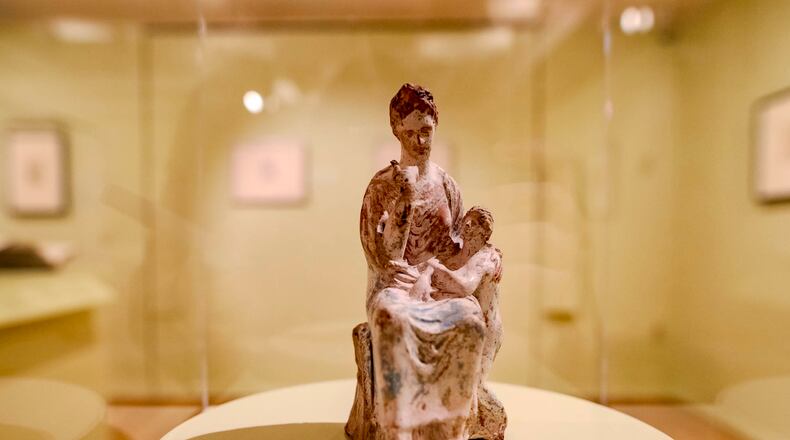At Emory University’s Michael C. Carlos Museum, there’s a new exhibit that is bringing together artifacts and artworks from disparate times. The “Recasting Antiquity” exhibition is the first of its kind that examines the connection between ancient statuettes called Tanagras and the sketches they likely inspired by famously cantankerous American artist James Abbott McNeill Whistler.
I was invited to join a media preview of the exhibition led by co-curators Dr. Ruth Allen, Curator of Greek and Roman Art, and Dr. Linda Merrill, who is a Whistler scholar, teaching professor, and Director of Undergraduate Studies in the Art History Department. Central to the exhibition are a number of immaculately presented statuettes surrounded by 30 of Whistler’s prints and drawings. Many of the statuettes are on loan from the Louvre Museum in Paris, France.
Credit: Isadora Pennington
Credit: Isadora Pennington
To understand the context of this exhibition, one must first step back in time to the Hellenistic period of Greece. In the late 1880s to mid 1890s, small statuettes depicting women draped in sumptuous fabric became popular in the region. Merril believes they were intended as funerary objects or votives, or as she called them “joyous companions of the grave.”
In 1870, farmers in Vrátsi, Greece began to uncover tombs and small terracotta statues buried in their fields. Discovered in large quantities, the figures were named “Tanagras” in honor of the ancient city that was the source of these creations.
“It was possible here at the Carlos to put together an exhibition where we combined the ancient and the modern, which hasn’t been done all that often,” explained Merrill. This exhibition is the first to contextualize Whistler’s work by presenting his work in juxtaposition with the Tanagras.
For Merrill, this exhibition is particularly special as she has a deep appreciation for the late expatriate American artist. “I was interested in Whistler initially because I loved his paintings,” she explained, “it was a pure aesthetic response. And then I became interested in his theories of art, and I wrote my dissertation on Whistler.”
For fifteen years, Merrill was the Curator of American Art at the Freer Gallery of Art in Washington which has the world’s premier collection of Whistler’s works, and through that experience she was able to deepen her understanding of the artist.
For Allen, part of the appeal of these statuettes lies in the details. The sumptuousness of their clothing, their elaborate hairdos, and the positions that allowed their fabric to appear to move have inspired wonder and inspiration throughout the ages.
“He was a difficult person, but he was a really amazing artist, I think. So I try to focus on that element,” she said with a laugh. She told me that in his life, Whistler was often in conflict and was under-appreciated, which led him to become bitter and challenging to those around him.
Credit: Isadora Pennington
Credit: Isadora Pennington
Allen was also particularly excited to offer insight as to the production process of these pieces through a display of a partial mold that was used to mass produce the figures. This rare and unique object illustrates the way in which craftspeople of the time would have created replicas of these items in bulk, rather than one at a time. The terracotta figures would have been removed from the mold, coated in a white slip, then fired, and later painted.
Allen and I spoke about the way these statuettes contribute to our understanding of the role of women during the Hellenistic period in Greece. She explained that the women pictured in these Tanagras would have been familiar characters in daily life. Wealthy, upper class women would have dressed in layers of silk, linen, and fine wools in bright colors. They were simultaneously modest, chaste, and fully covered with cloth, but also draped in such a way as to hint at their figures underneath the clothing.
“These are the competing expectations of women in the Greek world; you should be attractive and alluring but also modest,” explained Allen. “When you look at the idea of the woman, there’s always that dichotomy. You are expected to be beautiful, to be desirable, to be fertile, and childbearing is like the number one thing, but you also have to be modest and virtuous. So beauty is a really complicated concept in the Greek world. You are always caught between Aphrodite, and the prostitute, and the mother, and the wife.”
“These are statuettes that are kind of presenting an ideal Greek woman that is defined by men. Now, that ideal is a male ideal; we are talking about a patriarchal society,” Allen continued.
Credit: Isadora Pennington
Credit: Isadora Pennington
“These are women whose public selves are made through the act of getting dressed, so it’s all about the clothing, the jewelry, the cosmetics that they are wearing, the kind of sculpting of the female body. I think that there is space within that to think of women making themselves through the clothing and makeup that they wear. It’s an interesting fact that the ingredients of ancient makeup were the same as ancient paints, and also the same as ancient medicine. There’s something about painting the self, making up the self, and healing the self in a female context.”
While Tanagras never gained as much popularity in America as they did in Europe, Whistler’s time living abroad in Paris might have exposed him to those statuettes in the early 1890s. Merrill explained that Whistler’s perspectives on art and the way he worked with his models implies that he could have been inspired by the types of draping fabric popular in Tanagras.
As explained by Merrill, Whistler was known to allow his models to rest, to dance, and to move about in ways that were not so stiff as was typical of the time. He would sketch them in motion which lent his pieces a fluidity that seems to draw a connection between his works and the ancient statuettes.
Credit: Isadora Pennington
Credit: Isadora Pennington
While many may be most familiar with Whistler’s most famed painting, Arrangement in Gray and Black No. 1 which is commonly referred to as “Whistler’s Mother,” this exhibit offers a look into the depths of Whistler’s talents. The exquisite statuettes, when presented alongside Whistler’s drawings, paintings, lithographs, and etchings, prompt the viewer to consider the role of ancient art as an inspiration throughout history.
Credit: Rough Draft Atlanta
Credit: Rough Draft Atlanta
MEET OUR PARTNER
Today’s story comes from our partner, Rough Draft Atlanta. Rough Draft publishes Reporter Newspapers, community newspapers in Brookhaven, Buckhead, Dunwoody, and Sandy Springs. Visit them online at RoughDraftAtlanta.com or on Instagram @RoughDraftATL.
If you have any feedback or questions about our partnerships, you can contact Senior Manager of Partnerships Nicole Williams via email at nicole.williams@ajc.com.
About the Author
The Latest
Featured








